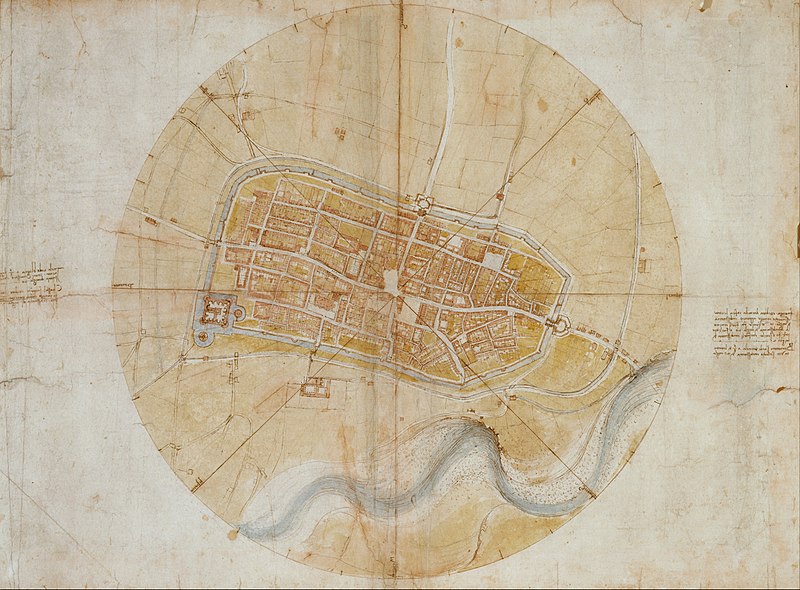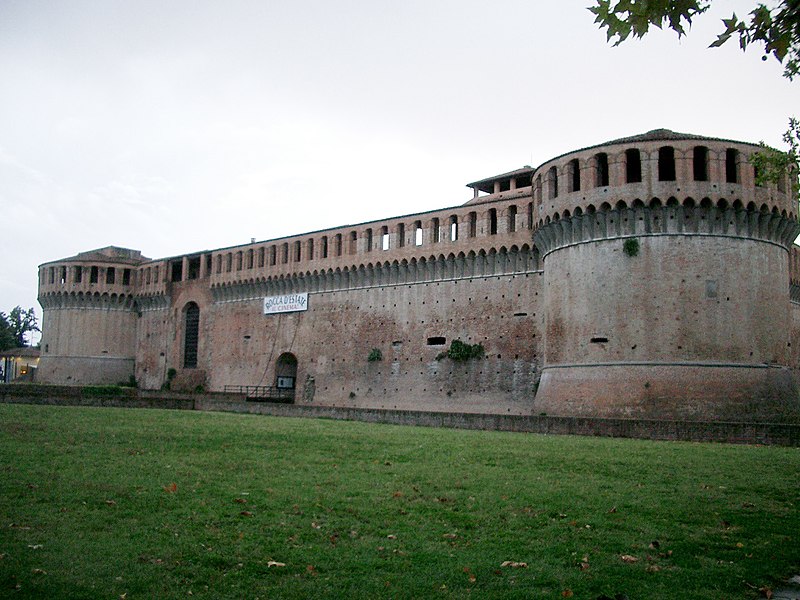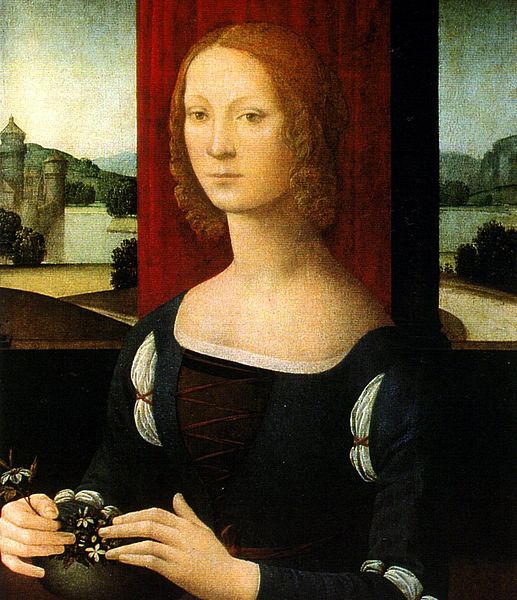 |
| Leonardo's map of Imola created for Cesare |
Rodrigo and
Cesare now intended a new offensive against the warlords of the papal states.
For centuries these lands had evaded control from Rome and their rulers went
their own way. Successive popes had failed to bring them back to the fold.
Cesare was intending to carve out a principality for himself within the papal
states; thus making himself secure once his father died.
On 18th
November 1499 Cesare returned to Rome in secret; he stayed with Rodrigo for a
week and then rode to Imola with. Louis had provided Cesare with
1,800 cavalry and 4,000 infantry, under the command of Yves d’Alègre, to assist
in subduing the Romagna and he used these French soldiers and a force of papal
troops to take Imola. Cesare also had a loan of 45,000 ducats[i] from the Milan treasury.
 |
| Rocca Sforzesca |
On 17th Imola surrendered;
‘This town he [Cesare]
assaulted and captured, together with its fortress, seizing and despoiling the
sons of the late Duke
Girolamo Riario[ii],
who were rulers of the city and nephews to Cardinal Raffaele
Riario[iii]. On
that same day Cardinal Riario……..fled to Monterotondo
with only a few attendants.’[iv]
Cardinal
Riario used the pretext of going hunting to flee the Holy City. A few days
later Riario travelled on to Sarzana, where he took refuge. Forli surrendered on 19th December,
but Caterina Sforza, who had ruled the city since the
death of her husband Giralamo, remained in possession of the citadel.
Assassination Attempt
On the day
that Cardinal Riario fled, one of the pope’s musicians attempted to poison
Rodrigo in the hope that Rodrigo’s death would free Forli and Imola from
Cesare’s rule.
‘On that evening, a certain
Tomasino of Forli, one of the pope’s musicians, was seized with a companion and
taken to the castel Sant Angelo where they were both imprisoned. Tomasino had
come to Rome with some poisoned letters that he had rolled up in a reed to
present to the pope.’[v]
 |
| Sistine Chapel |
On 8th
December Rodrigo attended mass in the Sistine Chapel; he was accompanied by his
nephew, Cardinal Juan de Borgia the elder who had not been seen in public for
some time. He was suffering from syphilis and had been for the past two years;
syphilis was now reaching epidemic proportions[vi].
The closing
weeks of 1499 saw Cesare, with French support, undertake a campaign in northern
Italy. The intention was to bring the petty lordships of the Romagna under
papal control.
Alexander
issued a bull declaring that all the lords of the Romagna had forfeited their
cities and many important families were excommunicated; the Riarii, the
Malatesta, the Manfredi, the Varani and the Montefeltri, along with Giovanni
Sforza. All these lords were declared dispossessed and their lands were to be
ruled by a new papal vicar; Cesare Borgia.
Jubilee Year
 |
| Alexander VI at prayer |
Alexander
had nominated 1500 as a jubilee year; pilgrims were expected to come to Rome in
their thousands. There were to be penitentiaries on duty throughout the year in
St Peter’s, to listen to the pilgrims’ confessions. The doors of the church
would be open day and night and a huge chest with three different locks had
been installed in the basilica to hold the pilgrims’ offerings.
On the night
of 14th January rumour ran riot in Rome; the news that Caterina
Sforza had been taken prisoner was greatly pleasing to Rodrigo. Cesare had
offered a reward of 10,000 ducats[vii] for Caterina’s capture.
‘The rumour spread through
Rome that the fortress of Forli, together with the Countess Caterina
Sforza…..had been treacherously and violently captured by Don Cesare Borgia and
that everyone else there had been put to the sword.’[viii]
 |
| Rocca Pesaro |
The French
demanded a ransom for Caterina which Cesare paid. She was initially imprisoned
in the Vatican, but after an escape attempt was moved to the Castel Sant’Angelo[ix]. Having subdued Forli, with
French help, Cesare now moved on to Pesaro.
On the 16th
January Cardinal Juan de Borgia the younger died; he’d recklessly ridden to
Forli to congratulate Cesare, whilst sick, and the fever had worsened. He was
buried on 27th without any pomp or ceremony.
On 12th
February Lucrezia purchased the papal fief of Sermoneta for 24,000 ducats[x]; she paid the Apostolic Chamber in cash. The money had undoubtedly come from Rodrigo,
so in essence the church was paying to give the fief to Lucrezia.
Return of the Sforza
 |
| Milan |
The French
troops were recalled to fight Ludovico Sforza who was nearing Milan with troops
loaned by his brother-in-law Maximilian. In early February the Milanese
revolted against their French overlords and Ludovico Sforza re-entered his
capital in triumph.
Ludovico’s
triumph was short lived as his hired Swiss troops refused to fight against Louis’
Swiss troops and returned home. Ludovico and his brother Cardinal Ascanio were
taken prisoner and were removed to France following Louis’ victory at Novara on 8th April. The Sforza
heir, the nine year old Francesco Sforza[xi], was taken into Louis’ custody and
was forced into the priesthood.
 |
| Francesco Sforza |
The attack
on Pesaro had to be postponed and Cesare returned to Rome to an ecstatic
welcome from his father who ordered that the city turn out to greet the
conquering hero, who succumbed to a bad attack of hubris and started
considering himself the equal of his namesake Julius Caesar.
‘His Holiness wished to
create Don Cesare the Captain-General and Gonfalier of the Holy Roman Church
and therefore, on March 29th, he ordered that he should be invested
with the Golden Rose.’[xii]
Rodrigo
bestowed on his son the Golden Rose, an honour normally reserved for royalty. At one point Cesare’s
campaign, to subdue the Romagna, was costing the Holy See half its income;
132,000 ducats[xiii]
over a two month period. Fortunately for Cesare’s ambitions, Rodrigo’s reforms
had resulted in increased revenues and Rodrigo was able to send money to
Hungary to aid their fight against the infidel.
The Prince of Rome
 |
| Caterina Sforza |
Cesare was
lord and master of Rome as well as the battlefield. Like his father Cesare
loved art and patronised poets and painters. Served by spies and informers,
Cesare ably administered Rome, but the death toll was sowing the seeds of his
future downfall;
‘Every night four or five
murdered men are discovered, bishops, prelates and others, so that all Rome
trembles for fear of being murdered by the Duke’[xiv]
wrote the
Venetian ambassador. Although skilled in martial arts and strong enough to
behead a bull with one blow, Cesare never left his palace unless he wore a
mask. This may have been meant as a disguise or to hide the blemishes left on
his face by the syphilis.
Around this
time Cesare was informed by Charlotte d’Albret that she was pregnant with his
child. Charlotte had remained in France, possibly held hostage for Cesare’s good behaviour.
On 17th May 1500 Charlotte d’Albret gave birth to a girl who was
named Louise.
Cesare was
not worried by his wife’s absence; his latest mistress was a Florentine
courtesan named Fiametta, but he never remained faithful to any one woman. His
proclivities were well-known in Roma and it was rumoured that he had raped
Caterina Sforza on numerous occasions since she had been taken captive.
On 24th
June Cesare took part in the Vatican’s celebration of the Feast of St John the Baptist. He displayed his bullfighting
skills, killing five bulls from horseback and the sixth on foot with a single
blow of his sword.
Bibliography
At the Court
of the Borgia – Johan Burchard, Folio Society 1990
Lucrezia
Borgia – Rachel Erlanger, Michael Joseph 1979
Florence and
the Medici – JR Hale, Phoenix Press 2001
The Rise and
Fall of the House of Medici – Christopher Hibbert, Folio Society 2001
The Borgias
– Mary Hollingsworth, Quercus Editions 2014
The Borgias
– GJ Meyer, Bantam 2013
A History of
Venice – John Julius Norwich, Penguin Books 1982
Absolute
Monarchs – John Julius Norwich, Random House 2011
The March of
Folly – Barbara Tuchman, Cardinal 1990
Niccolo’s
Smile – Maurizio Viroli, IB Tauris & Company Ltd 2001
www.wikipedia.en
[i]
In 2013 the relative: historic standard of
living value of that income or
wealth is £30,880,000.00 economic status
value of that income or wealth is £871,900,000.00 economic power value of that income or wealth is £12,290,000,000.00 www.measuringworth.com
[ii]
Former Captain-General of the Church and a nephew of Sixtus IV
[iii]
A witness to the murder of Giulano de’ Medici; Riario’s uncle was one of the
leaders in the Pazzi Conspiracy. Riario was also a relative of Rodrigo’s
opponent Cardinal della Rovere
[iv]
At the Court of the Borgia - Burchard
[v]
Ibid
[vi]
It was brought into Italy in 1494 in the wake of the invading French army
[vii]
In 2013 the relative: historic standard of
living value of that income or
wealth is £7,264,000.00 economic status
value of that income or wealth is £206,000,000.00 economic power value of that income or wealth is £2,896,000,000.00 www.measuringworth.com
[viii]
At the Court of the Borgia - Burchard
[ix]
Caterina was released on 30th June 1501 by the French, having been
held prisoner on the grounds that she had instigated Tomasino of Forli’s
attempt to poison Rodrigo. It is still uncertain whether she was involved in
the attempt.
[x]
In 2013 the relative: historic standard of
living value of that income or
wealth is £17,430,000.00 economic status
value of that income or wealth is £494,300,000.00 economic power value of that income or wealth is £6,949,000,000.00 www.measuringworth.com
[xii]
At the Court of the Borgia – Burchard
[xiii]
In 2013 the relative: historic standard of
living value of that income or
wealth is £95,890,000.00 economic status
value of that income or wealth is £2,719,000,000.00 economic power value of that income or wealth is £38,220,000,000.00 www.measuringworth.com
[xiv]
The March of Folly - Tuchman
No comments:
Post a Comment
Note: only a member of this blog may post a comment.